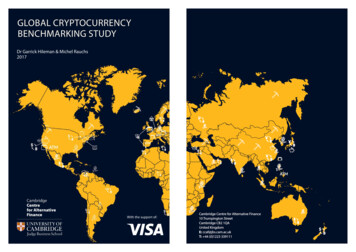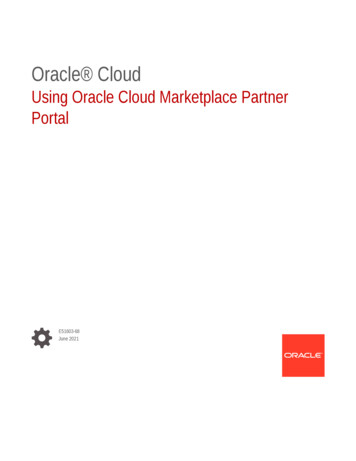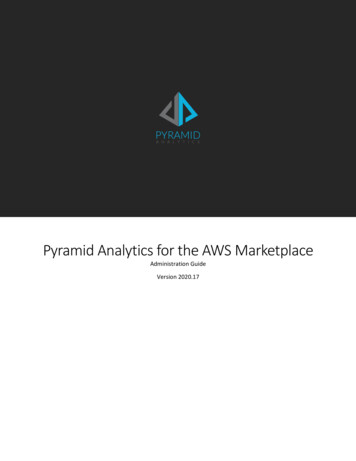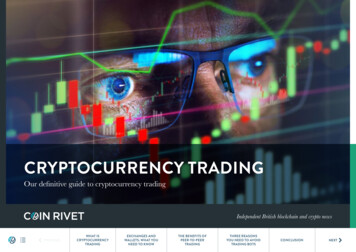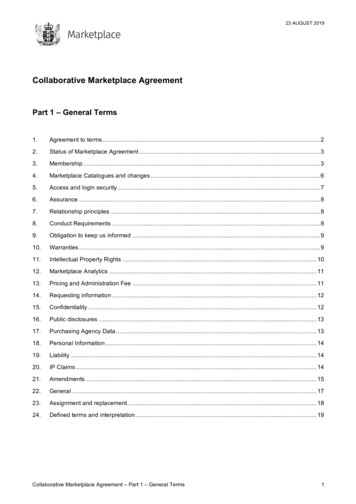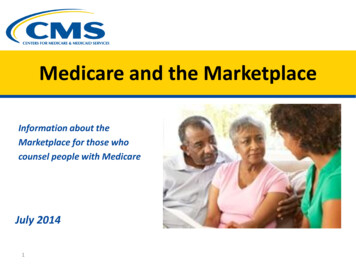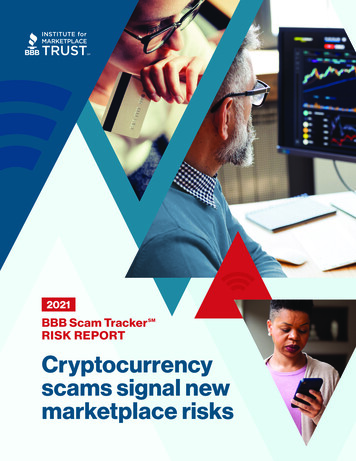
Transcription
2021BBB Scam TrackerRISK REPORTSMCryptocurrencyscams signal newmarketplace risks
2021BBB Scam TrackerRISK REPORTSMCryptocurrencyscams signal newmarketplace risks
Table ofContents4Introduction682021 overview– Infographic: 2021 Scam Tracker Risk Report highlights9BBB Risk Index: A three-dimensional approachto measuring scam risk1112Top scams reported by consumers in 2021– 10 riskiest consumer scams1313Online purchase scams remained riskiest in 2021– Tips for avoiding online purchase scams1414Cryptocurrency scams riskier in 2021– Tips for avoiding cryptocurrency scams151517Demographics– Age– Gender18Scam delivery and payment methods2424252728Impact on specific audiences– Canadian consumers– Military families and veterans– Students– Impersonated organizations/brands2929Scams reported by businesses– Top 3 riskiest and most reported business scams3030Fake invoice/supplier bill scams targetbusiness employees– Tips for avoiding fake invoice/supplier bill scams31Lifestyle changes may impact susceptibility3310 tips for avoiding a scam34BBB Institute for Marketplace Trust35Upgraded BBB Scam Tracker coming in 202236Acknowledgments37Project team38Appendix A: Glossary of scam types41Appendix B: Scam type data table, consumer scams42Appendix C: Top 10 scam types by overall risk,exposure, susceptibility, and monetary loss
IntroductionThe BBB Institute for Marketplace Trust (BBB Institute), the educational foundation of the Better BusinessBureau (BBB ), is pleased to present the 2021 BBB Scam Tracker Risk Report. This annual report usesdata submitted by individuals and businesses to BBB Scam Tracker SM (BBB.org/ScamTracker) to shedlight on how scams are perpetrated, who is being targeted, which scams have the greatest impact, andmuch more. Highlights of the 2021 report are provided in Figure 3.This report is a critical part of our ongoing work to share timely data and analysis to support the efforts ofall who are engaged in combating marketplace scams. Scams undermine trust in the marketplace, distortthe level playing field, and siphon money from legitimate transactions that could benefit both businessesand consumers, thus impeding economic growth. A healthy marketplace requires empowered andaware consumers and principled businesses that are proactively working to stop scammers and honortrustworthy relationships.Prevention is critical in our effort to reduce the impact of scams on consumers and businesses. Our riskreport findings enable BBB Institute to develop needed consumer educational programs and resources.These resources are delivered digitally and in person, leveraging the expansive network of BBBs servingcommunities across North America.Stopping scammers requires a multisector effort by government agencies and law enforcement, not-forprofits, the media, and the business community. BBB Institute shares its data with partners combatingfraud in the marketplace. We work with leaders in business, law enforcement, and government todetermine the best ways to stop scammers, and we partner with corporate partners and like-mindedorganizations to better allocate resources to tackle the problem, determine which prevention tactics areworking, and then evolve those tactics as needed.BBB Scam TrackerThe BBB Scam Tracker Risk Report is possible thanks to data from BBB Scam Tracker, an onlineplatform that enables consumers and businesses to report attempted or successful acts of fraud they’veexperienced. These instances of fraud are reviewed and posted for the public, empowering others toidentify scams and avoid losing money. In 2022, BBB Institute will launch a newly designed BBB ScamTracker platform (more detail about the project is available on page 35).4BBB.org/ScamTracker 2021 BBB SCAM TRACKER RISK REPORT
BBB Scam Tracker's impact goes farbeyond the tool itself. By monitoring realtime reports and overall trends, BBB, withlocal and network media partners, warnsthe public so as to reduce the impactof scammers.More than 1.6 million people visited theplatform in 20211 , with 49.3% reportingthat they sought to determine if they wereexperiencing a scam and 22.9% of thosevisitors reporting that BBB Scam Trackerhelped them avoid losing money to ascammer 2; we estimate BBB Scam Trackerhelped people save 31.4 million in 2021alone (Figure 1).Our survey research also found that 98.1% ofvisitors to BBB Scam Tracker sought to warnothers about a scam and 90.9% hoped tobring justice to the perpetrator. 2 We extendour thanks to the more than 276,000 citizenheroes who chose to speak out by reportingscams to BBB Scam Tracker to help othersavoid losing money.FIGURE 12021 BBB Scam Trackerimpact1,643,665Unique visitors to BBB Scam Tracker49.3%Visited BBB Scam Tracker to determinewhether they were experiencing a scamAbout 1 of every 5 visitors(22.9%) seeking to determine whether theywere experiencing a scam said BBB Scam Trackerhelped them avoiding losing money 169Median saved 31,360,459Estimated direct impact1Adobe Analytics.2Survey with 2,628 visitors to BBB Scam Tracker conducted in January 2022.BBB.org/ScamTracker 2021 BBB SCAM TRACKER RISK REPORT5
2021overviewThe data and insights gleaned via BBB Scam Tracker reports enable us to better understand the impactof scams being perpetrated in the marketplace. This report explores differences in risk borne by specificsubsets of the population. In 2021, more than 46,000 scams were published via BBB Scam Tracker, aslight decrease (0.9%) from 2020. Scam reports submitted by businesses and individuals across NorthAmerica are classified into 28 consumer scam types, 13 business scam types, and an “other” category,which represented 5.7% of all consumer reports (Appendix A). Data collected includes a descriptionof the scam, the dollar value of any loss, and information about the means of contact and method ofpayment. Optional demographic data (age, gender, and postal code) about the person targeted by thescam along with military and/or student status were also reported via the BBB Scam Tracker platform.See Appendix B and Appendix C for detailed data by scam type.One positive finding from this year’s report is that susceptibility (the percentage of consumers whoreported losing money when exposed to a scam) decreased for the first time since 2017, dropping8.4% from 46.7% in 2020 to 42.8% in 2021 (Figure 2). It is concerning, however, that reported mediandollar loss rose 47.0%, rebounding from an all-time low of 115 in 2020 to 169 in 2021.With a continued increase in online shopping, remote work, and general online and social media browsingin 2021, it’s not surprising that more scams were perpetrated online and yielded the highest likelihood offinancial loss. Similar to 2020, the top three contact methods in 2021 that resulted in a reported monetaryloss were website, social media, and email. Despite a slight drop in exposure and susceptibility, onlinepurchase scams remained the riskiest scam in 2021. This scam type had the highest exposure of anyscam type, comprising more than one-third of all scam types reported to BBB Scam Tracker, with almost75% of people reporting a monetary loss when targeted by an online purchase scam.Cryptocurrency scams rose to the second riskiest scam type in 2021 due to a reported increase in bothexposure and susceptibility. Although cryptocurrency scams made up only 1.9% of the scams reported toBBB Scam Tracker, the median dollar loss was 1,200, much higher than the overall median dollar loss of 169. More than 66% of people reported losing money when targeted by this scam type.This year, we also included the top scams reported by businesses. About 3.5% of all reports to BBBScam Tracker in 2021 were for scams targeting a business (see Figure 17). 3 When targeted by a scam,36Due to the self-reported nature of the scams, we estimate that 3.5% of total reports were related to scams targeting businesses.BBB.org/ScamTracker 2021 BBB SCAM TRACKER RISK REPORT
businesses reported losing money 21.7% of the time, significantly lower than the overall susceptibilityfor consumers (42.8%). However, the median dollar loss for businesses was higher ( 245) than forconsumers ( 169). More information about business scams can be found on page 29.FIGURE 2Figure 1a - SnapshotExposure by YearSnapshot of risk ,14360kNumber of scam reports5000050,559400000.9%from 20203000037,2832000010000Figure 1b - Snapshot0Susceptibility by Year0YR182018SUSCEPTIBILITY 100Percent of reports thatincluded dollar lossYR192019from 5.1%20Figure 1c - Snapshot0Monetary Loss by YearMONETARY LOSS 2500%YR18YR1920182019 152 160YR202020YR212021 250Median reported dollar loss20047.0%from 2020150100 169 115500 0YR18YR19YR20YR21BBB.org/ScamTracker 2021 BBB SCAM TRACKER RISK REPORT7
FIGURE 32021 Scam Tracker Risk ReportHIGHLIGHTSSCAMSREPORTEDDOWN46,143TOP 3 RISKIEST SCAMSREPORTEDBY CONSUMERSBY BUSINESSES0.9%LIKELIHOODOF LOSSDOWN42.8%8.4%MEDIAN LOSSUP 1691Online purchase1Fake invoice/supplier bill2Cryptocurrency2Bank/creditcard gservice47.0%ONLINE SCAMSCONTINUE TODOMINATEMore thanone third(37.4%) of all scamsreported in 2021 wereonline purchase scams.2021 CHANGES IN SCAM RISKCryptocurrency scams rose fromseventh to second riskiest.Amazon rose to the number one brandmost impersonated by scammers.59.8%reported shoppingonline more this yearas the pandemiccontinued.Almost 3out of every 4(74.9%) of thosetargeted by onlinepurchase scamsreported losingmoney.846.4%reported spendingmore time browsingsocial media.Onlinescamswere morelikely to resultin a reportedmonetary loss thanthose perpetratedin person orvia phone.BBB.org/ScamTracker 2021 BBB SCAM TRACKER RISK REPORTAbout the same percentage of peoplereported losing time as reported losingmoney after being targeted by a scam.Moving scams were the scam type withthe highest reported susceptibility.Foreign money exchange scamswere the scam type with thehighest monetary loss.Investment scams rose from the tenthto the fifth riskiest scams for all ages.
BBB Risk Index: A threedimensional approach tomeasuring scam riskTo better understand which scam types pose the highest risk, we assessed scams based on threefactors: exposure, susceptibility, and monetary loss. This unique formula is the BBB Risk Index (Figure 4).By combining these three factors, we gain a meaningful understanding of scam risk that goes beyond thevolume of reports received, enabling BBB and its partners to better target scam prevention outreach.Risk cannot be determined by viewing just one of these factors in isolation. For example, scams thatoccur in high volumes typically target as many people as possible but yield a lower likelihood of loss and/or monetary loss. In comparison, scams with a “high-touch” approach often reach fewer individuals, butthose exposed individuals are often more likely to lose money and to lose more money.FIGURE 4BBBRisk IndexThe formula for calculatingthe BBB Risk Index for a givenscam in a given population isExposure Susceptibility(Median Loss / Overall MedianLoss) x 1,000.BBB RISK INDEXEXPOSUREis a measure of theprevalence of a scamtype, calculated asthe percentage of aparticular scam typeas part of the totalscams reported.SUSCEPTIBILITYis a measure of thelikelihood of losingmoney when exposed toa scam type, calculatedas the percentage of allreports that reporteda monetary loss.The BBB Risk Index does not factor in the emotional and psychologicalharm scams can inflict or the damage done in diminishing trust in themarketplace due to those perpetrating fraud. Our survey research 4explored the non-financial impacts of scams (Figure 5). More than 44%reported losing confidence or peace of mind because of the emotionalimpact of being targeted by a scam. Another interesting finding: aboutthe same percentage of people (55.5%) reported losing time as reportedlosing money after being targeted by a scam.4MONETARY LOSSis calculated as themedian dollar amountof losses reportedfor a particular scamtype, excludingreports whereno loss occurred.About the samepercentage ofpeople reportedlosing time asreported losingmoney afterbeing targetedby a scam.A survey was distributed to those who submitted a scam to BBB Scam Tracker in 2021; 5,258 respondents completed the survey.BBB.org/ScamTracker 2021 BBB SCAM TRACKER RISK REPORT9
Non-financial impacts of being targeted by a scamFIGURE 5Lost timeLost confidence/peace of mindLost personalinformation(due to stress oremotional impact)Lost financial/credit healthLost potentialearnings(credit score)55.5%44.4%35.3%6.7%6.0%of responsesof responsesof responsesof responsesof responsesWe sought to better understand which scam types were most often reported as resulting innon-financial impacts (Figure 6).Top scam types with reported non-financial impacts and monetary lossFIGURE 6RentalscamsDebt collectionscamsIdentity theftscamsEmploymentscamsAdvance feeloan scamsLost timeLost confidence/peace of mindLost personalinformationLost potentialearningsLost financial/credit health78.4%70.6%65.2%32.6%27.3%of responsesof responsesof responsesof responsesof responsesNote: Includes only scams reported by those reporting a monetary loss and scams that targeted them as an individual.10BBB.org/ScamTracker 2021 BBB SCAM TRACKER RISK REPORT
Top scams reportedby consumers in 2021Based on the BBB Risk Index and reports submitted to BBB Scam Tracker in 2021, the 10 riskiestscams (Table 1) pose the most significant risks to consumers; the list changed slightly with somenotable shifts from 2020.Onlinepurchasescams madeup more thana third of allscams reportedin 2021 andcryptocurrencyscams werethe secondriskiest scam.Not surprisingly, online purchase scams 5 were the riskiest scamtype for the second year in a row with people continuing to adjustto life with COVID-19. According to our survey research, 59.8% ofrespondents shopped more online in 2021 and 46.4% spent moretime browsing online (including social media). Online purchasescams made up 37.4% of all scams reported to BBB Scam Trackerin 2021, with 74.9% reporting a monetary loss.Cryptocurrency scams were the second riskiest scam in 2021,rising from seventh riskiest in 2020. Although cryptocurrencyscams made up only 1.9% of the scams reported to BBB ScamTracker in 2021, the median dollar loss was 1,200, much higherthan the overall median dollar loss of 169. More than 66% ofpeople reported losing money when targeted by this scam type.Employment scams have been in the top three riskiest scams sincewe began publishing the BBB Scam Tracker Risk Report in 2016. In2021, employment scams dropped from second riskiest to third.The susceptibility and median dollar loss of this scam type dropped slightly, while the number of reportedscams increased from 7.1% in 2020 to 7.8% in 2021.Other notable changes to the top 10 list include the rise of government grant scams to the eighth riskiestin 2021, up from the 13th spot in 2020 due to a rise in median dollar loss (up from 800 in 2020 to 1,000in 2021) and susceptibility (up from 15.9% in 2020 to 19.5% in 2021). Romance scams, however, droppedfrom sixth on the list in 2020 to the 14th slot in 2021 because of a drop in median dollar loss (down from 2,100 in 2020 to 900 in 2021) and susceptibility (down from 45.9% in 2020 to 36.6% in 2021).5Additional information about online purchase scams can be found in the 2021 Online Purchase Scams Report, published byBBB Institute for Marketplace Trust.BBB.org/ScamTracker 2021 BBB SCAM TRACKER RISK REPORT11
10 riskiest consumer scams in 2021TABLE 1RANK12SCAM TYPE2021202011Online purchase273BBB RISKINDEXEXPOSURESUSCEPTIBILITYMEDIAN .8% 101 96Cryptocurrency90.61.9%0.7%66.2%55.8% 1,200 1,2002Employment63.07.8%7.1%15.1%16.6% 900 96745Homeimprovement45.21.4%0.7%59.1%58.7% 955 1,193510Investment29.90.8%0.6%56.9%67.2% 1,100 94863Fake check/money order27.12.1%2.7%14.8%16.6% 1,475 1,67974Advance fee loan25.91.8%1.6%40.6%47.1% 609 745813Governmentgrant24.82.2%2.0%19.5%15.9% 1,000 80098Tech support22.03.1%3.1%24.3%28.2% 500 .9% 700 1,300BBB.org/ScamTracker 2021 BBB SCAM TRACKER RISK REPORT
Online purchase scams remained riskiest in 2021Online purchase scams made up more than one-third of scams reportedto BBB Scam Tracker in 2021. About 75% reported losing money whentargeted by this scam type. As a result, it ranked as the #1 riskiest scamfor the second year in a row. Puppy scams continued to top the list ofproducts most used to perpetrate online purchase scams.The following scam report was submitted by a woman, age 25-34,from Illinois:We reached out to what seemed like a legitimate dogbreeder to purchase a puppy. Transaction for puppywent through, fake Bill of Sale was produced. Red flagswent off when the shipping company the “breeder”uses said they charge 1,380 for shipping but refund 1,350 once the puppy is delivered to us. Seemedodd that including airfare, it would only cost 30 toship him started doing reversed image searchesand scam searches and the shipping company cameup as a reported scam, but not the fake “breeders”themselves. I want to make sure no more people gettaken advantage of.”TIPS FOR AVOIDING ONLINE PURCHASE SCAMSBe very wary of purchasing a pet online.Never use an online payment system to pay somebodyyou don’t know.Search BBB Scam Tracker to see if another person hasreported the person or business as a scammer.BBB.org/ScamTracker 2021 BBB SCAM TRACKER RISK REPORT13
Cryptocurrency scams riskier in 2021Cryptocurrency scams rose from seventh riskiest in 2020 to the secondriskiest scam in 2021. We received many reports of people being targetedon a variety of social media platforms by scammers offering to help theminvest in bitcoin.The following scam report was submitted by a student, age 25-34,from Indiana:They hacked my friend's Instagram account and madeit seem like they would be helping her invest money. Sothey tricked her, which tricked me. They had her posta video saying she got 10,000 after investing 500in less than an hour. So they convince you to transfermoney to cashapp and then make it bitcoin to whichyou then send it off to them. They have you sign up fortheir website to see the money that “accumulated”to 10,000. But what they try to do after that is haveyou give this processing fee of 1,500 to put yourapplication of withdrawal, of the 10,000 dollars, to youraccount. And if you don’t have that money they say theircompany will pull the cost if you make a video sayingthat you got 10,000 by investing 500 dollars inbitcoin through this firm and this agent on Instagram.”TIPS FOR AVOIDING CRYPTOCURRENCY SCAMSBe very wary of anyone offering to make youquick money with little risk.Scammers can pretend to be your friend on social mediaby hacking into their accounts. Always check directly withthe person before clicking a link or paying them money.If somebody claims to be a broker, check themon FINRA’s BrokerCheck tool.Never use an online payment system to paysomebody you don’t know.Search BBB Scam Tracker to see if another person hasreported the person or business as a scammer.14BBB.org/ScamTracker 2021 BBB SCAM TRACKER RISK REPORT
DemographicsThe collection of self-reported demographic data such as age, gender, and racial background enhancesour ability to identify individuals who are most at risk and helps us better understand how the nature of riskvaries across different subgroups of the population. We use this information to enhance how we targetoutreach and educational strategies. BBB creates content, resources, and programming aimedat empowering consumers and businesses alike to identify and avoid scams.AgeIn 2021, allage groupsreported ahigher medianloss in 2021,with peopleages 65 reporting ahigher medianloss than allother agegroups.In 2021, when targeted by a scam, younger people reported losingmoney at higher rates than older people. All age groups reporteda higher median loss in 2021, with people ages 65 reporting ahigher median loss ( 200) than all other age groups (Figure 7).However, younger age groups had the next highest monetary loss,with ages 25–34 reporting a median dollar loss of 175 and ages18–24 reporting a monetary loss of 170.Table 2 highlights the three riskiest scams by age. Online purchasescams were the riskiest for all age groups in 2021. Cryptocurrencyscams were the second riskiest for ages 25–64. Employmentscams were second riskiest for ages 18–24 and third riskiest forages 25–44 and 55–64. Interestingly, investment scams were thirdriskiest for ages 18–24 for the first time since we began publishingthe risk report. The rise of cryptocurrency scams as the secondriskiest overall in 2021 may play a role in the rise of investmentscams as the third riskiest for this age group.BBB.org/ScamTracker 2021 BBB SCAM TRACKER RISK REPORT15
0182535455565SUSCEPTIBILITYEXPOSUREExposure, susceptibility, and median dollar lossof all scam types by ageFIGURE EPTIBILITY30.9%303020.3%2020LOSS10 10300 0 5–5455–6465 18 1825 2535 3545 4555 5565 65MEDIAN LOSS 200200150100500EXPOSURE 169 170OverallMedian Loss 157 15935–4445–54605018–2425–34302018–241 15055–6465 40AGE18AGE25Three riskiest scam types by ageTABLE 216 AGE45AGE5545–54AGE6555–6465 Online purchase camsEmploymentscamsBBB.org/ScamTracker 2021 BBB SCAM TRACKER RISK l/vacation/timesharescamsTech supportscams
GenderGenderSUSCEPTIBILITY EXPOSURESimilar to previous years, more than two-thirds of reports to BBB Scam Tracker in 2021 were submittedby women; one-third of reports were submitted by men. Women were slightly more susceptible to losingmoney when exposed to a scam (43.6%) compared to men (42.9%) (Figure 8). The median dollar loss forwomen ( 150) was significantly lower than that for men ( 220). Online purchase scams were again theriskiest scams for men and women (Table 3). Cryptocurrency scams were the second riskiest for men andthe third riskiest forwomen.GenderSUSCEPTIBILITY EXPOSUREExposure, susceptibility, and median dollar lossbyWomengenderFIGURE 8EXPOSURESUSCEPTIBILITYWOMENMENMEDIAN LOSS66.8%Women 15043.6%33.2%Men 22042.9%02040608010080100MenThree riskiest scam types by genderTABLE 30WOMEN1204060MENOnline purchase rencyscamsHome improvementscamsBBB.org/ScamTracker 2021 BBB SCAM TRACKER RISK REPORT17
Scam delivery andpayment methodsWith a continued increase in online shopping, remote work, and general online browsing in 2021, it’snot surprising that more scams were perpetrated online and yielded the highest reported financialloss. Similar to 2020, the top three contact methods in 2021 resulting in a reported monetary loss werewebsite, social media, and email (Figure 9). Internet messaging rose slightly this year, up from 5.3% in2020 to 6.1% in 2021. It’s interesting to note that while in-person scams dropped significantly from 2019(3.3%) to 2020 (1.5%), they rose 60% to 2.4% in 2021.Phone continues to be the most common contact method reported to BBB Scam Tracker (24.4%),followed by email (18.6%) and website (17.9%) (Figure 9). Though fewer people reported losing moneywhen targeted by phone (17.9%) than those targeted by website (73.7%) and social media (72.0%), themedian dollar loss for scams perpetrated by phone ( 573) was higher than website ( 100) and socialmedia ( 90). Scams perpetrated via text message had a reported median dollar loss of 630 with 21.4%reporting they lost money when targeted. Scams perpetrated via online means were more prevalentoverall than other delivery methods (56.8%), with a higher percentage of people losing money whentargeted (78.4%) (Figure 10).This year we examined the means of contact for monetary loss by age. Ages 65 were less likely toreport losing money when targeted via social media, email, and websites than other age groups, butthey were more likely to report losing money when targeted by phone, Internet messaging, and onlineclassifieds (Figure 11).18BBB.org/ScamTracker 2021 BBB SCAM TRACKER RISK REPORT
FIGURE 9Percent of scams reported with monetary losscompared with total scams reported by means of contactPERCENTAGE OF REPORTED SCAMS WITH LOSSPERCENTAGE OF ALL REPORTED SCAMSWebsiteWEB30.8%17.9%Social mediaSOCIAL(e.g., HONEInternet messagingI.MSG(e.g., WhatsApp)24.4%6.1%5.2%4.6%Text messageT.MSGOnline classifiedsO.CLASS(e.g., Craigslist)9.1%3.5%2.9%2.4%1.8%In personIN PERS.1.3%Postal eptibility and monetary loss by means of contactMEANS OF CONTACTSUSCEPTIBILITYMEDIAN LOSSWebsite73.7% 100Social media (e.g., Facebook)72.0% 90Email40.0% 239Phone17.9% 573Internet messaging (e.g., WhatsApp)50.7% 436Text message21.4% 630Online classifieds (e.g., Craigslist)52.3% 238In person56.6% 700Postal mail10.3% 150Other48.3% 189BBB.org/ScamTracker 2021 BBB SCAM TRACKER RISK REPORT19
FIGURE 10Percent of scams reported with monetary losscompared with total reported scams by means of contactOnline(includes website, social media,email, internet messaging,and online classifieds)Phone(includes phoneand text messaging)In person(includes in personand postal mail)56.8%33.5%7.0%of all scams reportedof all scams reportedof all scams reported78.4%14.8%3.7%of all scams reported with a lossof all scams reported with a lossof all scams reported with a lossNote: Percentage of all scams and scams with a loss do not add up to 100% because the "other" category was not included.20BBB.org/ScamTracker 2021 BBB SCAM TRACKER RISK REPORT
Contact by Website/ AgesFIGURE 1150Percent of scam reports resulting in monetary lossby means of contact and ageTOP REPORTEDMEANS OF CONTACT4018 –2425 – 3431.1%Website3035 – 4432.6%45 – 5455 – 6465 31.9%30.1%29.5%25.2%21.8%21.3%19.2%18.6%Social 5%10OTHER REPORTEDMEANS OF CONTACT18-2425–3435–4445–5455–6465 Phone8.9%9.4%9.0%9.4%10.0%15.9%Internet messaging(e.g., WhatsApp)5.8%6.1%4.8%5.7%6.7%8.9%Text message4.9%4.2%4.1%5.2%5.6%3.9%Online classifieds2.6%2.6%2.6%4.2%4.5%4.3%In person3.1%2.7%2.5%2.2%2.1%2.4%Postal .4%5.6%0BBB.org/ScamTracker 2021 BBB SCAM TRACKER RISK REPORT21
Credit cards (37.7%) remained the top reported payment methodwith a monetary loss in 2021 (Figure 12). Online payment systemswere the second most common payment type with a dollarloss, up slightly from 31.2% in 2020 to 32.0% in 2021. Anothersignificant finding in this year’s report is that payment madevia cryptocurrency that resulted in a monetary loss more thandoubled from 2020 (1.5%) to 3.4% in 2021. The payment methodswith the highest median dollar loss were wire transfer ( 1,450),cryptocurrency ( 1,200), check ( 900), and prepaid card ( 700).Paymentmade viacryptocurrencythat resultedin a monetaryloss more thandoubled from2020.FIGURE 12Percent of total scam reports resulting in monetary loss by payment methodPayment Methods w/Loss - % of TotalPayment Methods w/Loss - Median Loss% TOTAL REPORTSCredit cardOnline paymentsystemBank account debitPrepaid card(e.g., gift card)CryptocurrencyCheckCREDITCREDIT37.7%ONLINE PS32.0% ONLINE PS12.7%BANKBANK5.4%PP CARD3.4%CRYPTOCHECKCashCASH2.3%CASHWire transfer(e.g., Western Union)WIRE1.8%WIREM ORDER0.6%M ORDEROTHER1.8%OTHER010 200 100 700 1,200CRYPTO2.3%Other 85PP CARDCHECKMoney Order22MEDIAN LOSS2030BBB.org/ScamTracker 2021 BBB SCAM TRACKER RISK REPORT40500 900 631 1,450 625 48530060090012001500
When broken out by age, younger ages reported more instances of losing money via online paymentsystem, bank account debit, and cryptocurrency (Figure 13). Older adults reported more instances oflosing money via prepaid cards, credit card, and check.Contact by Website/ AgesFIGURE 13Percent of scam reports resulting in monetary lossby payment method and age50TOP REPORTEDPAYMENTMETHODS40Onlinepaymentsystem3018 –242035 – 4436.2%35.1%45 – 5455 – 6438.9%39.1%65 44.6%Credit card34.3%36.1%33.3%Credit cardBank accountdebit25 – 34Online .3%11.0%11.7%10OTHER REPORTEDPAYMENT METHODS18-2425–3435–4445–5455–6465 .6%2.0%2.2%2.2%5.3%Wire transfer(e.g., Western Union)1.9%1.7%1.5%1.6%2.0%2.3%Money 1.4%1.6%Prepaid card0BBB.org/ScamTracker 2021 BBB SCAM TRACKER RISK REPORT23
Impact onspecific audiencesCanadian consumersIn 2021, Canadian consumers reported 1,687 scam reports to BBB Scam Tracker (3.7% of total reports).The median reported loss was 250 CAD in 2021, which is an increase from 205 CAD in 2020.Susceptibility decreased slightly from 46.3% in 2020 to 45.1% in 2021. These trends—an increasein median dollar loss with a decrease in susceptibility—mirror the overall findings from all BBBScam Tracker submissions, which include scams reported by U.S. consumers.The riskiest scam type reported by Canadians in 2021 wascryptocurrency scams, due to the high susceptibility (69.6%) and amedian dollar loss of 1,500 CAD (Table 4). Advance fee loan scamsfell from the riskiest scam reported by Canadians in 2020 to thesecond riskiest in 2021, with a susceptibility of 57.7% and a mediandollar loss of 1,000 CAD. The third riskiest scam type reported inCanada was online purchase scams, again making up almost a thirdof all scams reported by Canadians. Notably, phishing scams rosefrom the seventh riskiest scam in 2020
platform that enables consumers and businesses to report attempted or successful acts of fraud they've experienced. These instances of fraud are reviewed and posted for the public, empowering others to . 1 Adobe Analytics. 2 Survey with 2,628 visitors to BBB Scam Tracker conducted in January 2022. Unique visitors to BBB Scam Tracker 1,643,665

